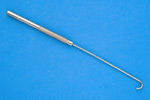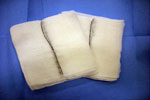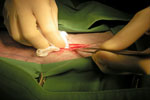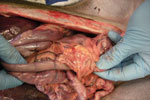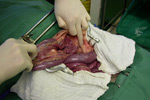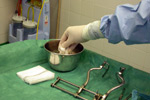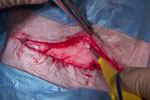Equipment Instruments
Unit 9: Basic Instruments
Topic 2d: Accessory instruments and equipment
Probes
Most standard kits contain a malleable probe for insertion into cavities and exploration of sinuses.
Spay Hooks
Spay hooks are a blunt ended hook used to elevate the uterus up through a key-hole incision. They are also useful as a retractor.
Suction tubes and nozzles
Maintaining a clean operating field is essential in most surgical procedures to optimise visualisation of the tissues.
Suction provides the best means for removal of lavage solution, body fluids (eg urine, bile) and blood. It is efficient, fast, and allows for measurement of the solution removed. Complete removal of lavage solution is important to avoid dilution of bioactive agents such as opsonins, which are required for phagocytosis.
Suction pressures of 80 to 120 mm Hg are suitable for most general purposes. Higher pressures must be used with caution to avoid aspiration injury to tissues. Suction tips with multiple fenestrations are more effective and less likely to block. They are less likely to injure tissues.
The Yankauer and Pool tips are suited for body cavities. For more precise suction in a confined space such as during spinal decompression, the Frazier tip, which has a finger port near the handle to vary suction pressure, is recommended.
Swabs
Cotton swabs are used to absorb blood to facilitate visualization of tissues, and also to apply pressure onto bleeding vessels.
Swabs are easily lost in body cavities, particularly if there is significant bleeding.
In major procedures involving body cavities it is advisable to count the swabs prior to surgery and at the completion of the procedure.
Most swabs also contain a radio-dense marker to allow detection by radiology.
Abdominal Packs
Cotton abdominal packs are larger double sided pieces of material which are usually moistened with saline and used to pack of organs such as the lungs or intestine and protect them during surgical procedures.
They may also be used to absorb blood.
Sterile saline is frequently placed into a stainless steel bowl on the surgery table. This saline is use to keep the tissues of the patient moist to prevent drying out of, for example, serosal surfaces in order to reduce serosal pain and adhesions.
Saline is also used as a lavage solution in contaminated wounds.
Electrosurgery Equipment
See: Unit 6: Topic 4
See: Unit 9: Basic Instruments (Table Set-Up)

